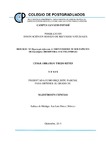| dc.contributor.advisor | Morales Flores, Francisco Javier | Es |
| dc.contributor.advisor | Villegas Rodríguez, Fabiola | Es |
| dc.creator | TREJO REYES, CESAR ABRAHAM; 854749 | |
| dc.date.accessioned | 2020-04-16T17:16:12Z | |
| dc.date.available | 2020-04-16T17:16:12Z | |
| dc.date.issued | 2019-12 | |
| dc.identifier.citation | Trejo Reyes, César Abraham (2019). Biología de Hyperaspis trifurcata alimentándose de dos especies de Dactylopius (Hemiptera: Dactylopiidae). Salinas de Hidalgo, S. L. P.: El autor, Tesis (Maestría en Ciencias, especialista en Innovación en el Manejo de Recursos Naturales), Colegio de Postgraduados, Campus San Luis Potosí, 2019 | es_MX |
| dc.identifier.uri | http://hdl.handle.net/10521/4273 | |
| dc.description.abstract | Opuntia ficus-indica es la cactácea de mayor valor económico en el mundo, y las plagas son una de las principales causas de disminución en su rendimiento. Dactylopius opuntiae es un insecto escama que se considera su plaga clave en México, y otros países donde se aprovecha esta cactácea. Por otra parte, la especie D. coccus, la cual se cultiva para la obtención de ácido carmínico se reportó, recientemente, como plaga en Etiopía. Debido a que las tácticas de manejo que se han implementado para controlar estas especies no han sido satisfactorias, se considera que el control biológico puede ser una alternativa sostenible para poder atacar el problema. No obstante, se desconoce sí sus enemigos naturales se pueden desarrollar adecuadamente sobre las dos especies, ya que cada una de ellas contiene diferente concentración de ácido carmínico, metabolito que se considera tiene efectos de antidepredación. El objetivo de este trabajo fue conocer la biología de Hyperaspis trifurcata (Coleoptera: Coccinellidae) al consumir ambas especies de Dactylopius. En la primera parte del trabajo se determinaron los parámetros demográficos sobre las dos especies de Dactylopius, y en la segunda se probó la preferencia de H. trifurcata sobre ninfas y adultas de las dos especies. La supervivencia de H. trifurcata fue de 65.4% versus 42.3%, y el tiempo de desarrollo de 36.1 versus 40.0 d, cuando se alimentó de D. opuntiae y D. coccus, respectivamente. El tiempo de generación, tasa neta de reproducción, tasa intrínseca de crecimiento natural y el tiempo para duplicar la población fueron mayores cuando el depredador se alimentó con D. opuntiae comparado con D. coccus, que contiene una concentración de ácido carmínico mayor. H. trifurcata consumió ninfas de primer ínstar de una u otra especie de Dactylopius sin mostrar preferencia. No obstante, prefirió consumir hembras adultas de D. opuntiae en comparación con D. coccus, esta preferencia presumiblemente se atribuyó a la diferencia en la concentración de ácido carmínico. En el presente trabajo se discuten las posibles consecuencias de estos hallazgos en este enemigo natural de D. opuntiae. | es_MX |
| dc.description.abstract | Opuntia ficus-indica is the cacti with the highest economic value in the world, with pests being the main causes of decline in yield. Dactylopius opuntiae is a scale insect that is considered its key pest in Mexico and other countries in the world. On the other hand, just recently D. coccus which is grown for the production of carminic acid has been reported as a pest in Ethiopia. Because the control tactics against both species have not been satisfactory, the biological control can be a sustainable way to regulate the problem. Nevertheless, it is unknown if its natural enemies can develop properly on the two species that contain different concentration of carminic acid, which can be used against their predators. The objective of this work was to establish particularities of the biology of Hyperaspis trifurcata (Coleopteran: Coccinellidae) as it consumed both species of Dactylopius. In the first part of the work the demographic parameters on the two prey species were determined, in the second one the preference of H. trifurcata for feeding either on first instar nymphs or gravid females was tested. The survival of H. trifurcata was 65.4% versus 42.3%, the development time of 36.1 versus 40.0 d when fed on D. opuntiae and D. coccus, respectively. The generation time, net reproduction rate, intrinsic rate of natural growth and the time to double the population were greater when the predator was fed with D. opuntiae compared with D. coccus which has higher concentration of carminic acid. In the second part of the work, H. trifurcata consumed first instar nymphs of any species of Dactylopius without showing preference. Nevertheless, the predator preferred to consume adult females of D. opuntiae compared to D. coccus, presumably because of the difference in carminic acid concentration. In the present work we will discuss the possible consequences of findings in this natural enemy of D. opuntiae. | es_MX |
| dc.description.sponsorship | Conacyt | es_MX |
| dc.format | pdf | es_MX |
| dc.format.extent | 1010 Kb | Es |
| dc.language.iso | spa | es_MX |
| dc.publisher | El Autor | es_MX |
| dc.rights | Acceso abierto | Es |
| dc.rights.uri | http://creativecommons.org/licenses/by-nc-nd/4.0 | es_MX |
| dc.subject.classification | CIENCIAS AGROPECUARIAS Y BIOTECNOLOGÍA::CIENCIAS AGRARIAS::FITOPATOLOGÍA::CONTROL BIOLÓGICO DE ENFERMEDADES | es_MX |
| dc.subject.other | Dactylopius opuntiae | |
| dc.subject.other | Cochinillas del nopal | Es |
| dc.subject.other | Control biológico | Es |
| dc.subject.other | Ácido carmínico | Es |
| dc.subject.other | Dactylopius opuntiae | |
| dc.subject.other | Dactylopius coccus | |
| dc.subject.other | Maestría | Es |
| dc.subject.other | IMRN | Es |
| dc.title | Biología de Hyperaspis trifurcata alimentándose de dos especies de Dactylopius (Hemiptera: Dactylopiidae) | es_MX |
| dc.title.alternative | Biology of Hyperaspis trifurcata feeding on two species of Dactylopius (Hemiptera: Dactylopiidae) | es_MX |
| dc.type | Tesis | es_MX |
| dc.subject.ingles | Cochineal | En |
| dc.subject.ingles | Carminic acid | En |
| dc.subject.ingles | Biological control | Es |
| dc.subject.nal | Opuntia ficus-indica | Es |
| dc.type.conacyt | masterThesis | es_MX |
| dc.identificator | 6||31||3108||310802 | es_MX |
| dc.contributor.director | MENDEZ GALLEGOS, SANTIAGO DE JESUS; 120378 | |
| dc.audience | generalPublic | es_MX |


